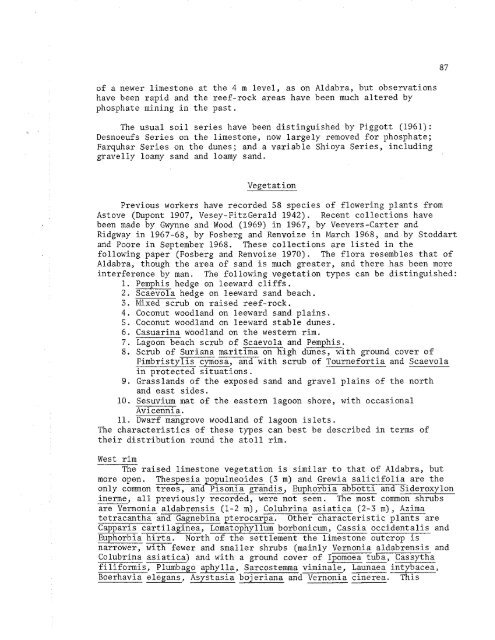ATOLL RESEARCH BULLETIN - Smithsonian Institution
ATOLL RESEARCH BULLETIN - Smithsonian Institution
ATOLL RESEARCH BULLETIN - Smithsonian Institution
You also want an ePaper? Increase the reach of your titles
YUMPU automatically turns print PDFs into web optimized ePapers that Google loves.
of a newer limestone at the 4 m level, as on Aldabra, but observations<br />
have been rapid and the reef-rock areas have been much altered by<br />
phosphate mining in the past.<br />
The usual soil series have been distinguished by Piggott (1961):<br />
Desnoeufs Series on the limestone, now largely removed for phosphate;<br />
Farquhar Series on the dunes; and a variable Shioya Series, including<br />
gravelly loamy sand and loamy sand.<br />
Vegetation<br />
Previous workers have recorded 58 species of flowering plants from<br />
Astove (Dupont 1907, Vesey-FitzGerald 1942). Recent collections have<br />
been made by Gwynne and Wood (1969) in 1967, by Veevers-Carter and<br />
Ridgway in 1967-68, by Fosberg and Renvoize in March 1968, and by Stoddart<br />
and Poore in September 1968. These collections are listed in the<br />
following paper (Fosberg and Renvoize 1970). The flora resembles that of<br />
Aldabra, though the area of sand is much greater, and there has been more<br />
interference by man. The following vegetation types can be distinguished:<br />
1. Pemphis hedge on leeward cliffs.<br />
2. Scaevola hedge on leeward sand beach.<br />
3. Mixed scrub on raised reef-rock.<br />
4. Coconut woodland on leeward sand plains.<br />
5. Coconut woodland on leeward stable dunes.<br />
6. Casuarina woodland on the western rim.<br />
7. Lagoon beach scrub of Scaevola and Pemphis.<br />
8. Scrub of Suriana maritima on high dunes, with ground cover of<br />
Fimbristylis cymosa, and with scrub of Tournefortia and Scaevola<br />
in protected situations.<br />
9. Grasslands of the exposed sand and gravel plains of the north<br />
and east sides.<br />
10. Sesuvium mat of the eastern lagoon shore, with occasional<br />
Avicennia.<br />
11. Dwarf mangrove woodland of lagoon islets.<br />
The characteristics of these types can best be described in terms of<br />
their distribution round the atoll rim.<br />
West rim<br />
The raised limestone vegetation is similar to that of Aldabra, but<br />
more open. Thespesia populneoides (3 m) and Grewia salicifolia are the<br />
only common trees, and Pisonia grandis, Euphorbia abbotti and Sideroxylon<br />
inerme, all previously recorded, were not seen. The most common shrubs<br />
are Vernonia aldabrensis (1-2 m), Colubrina asiatica (2-3 m), - Azima<br />
tetracantha and Gagnebina pterocarpa. Other characteristic plants are<br />
Capparis cartilaginea, Lomatophyllwn borbonicum, Cassia occidentalis and<br />
Euphorbia hirta. North of the settlement the limestone outcrop is<br />
narrower, with fewer and smaller shrubs (mainly Vernonia aldabrensis and<br />
Colubrina asiatica) and with a ground cover of Ipomoea tuba, Cassytha<br />
filiformis, Plumbago aphylla, Sarcostemma viminale, Launaea intybacea,<br />
Boerhavia elegans, Asystasia bojeriana and Vernonia cinerea. This

















